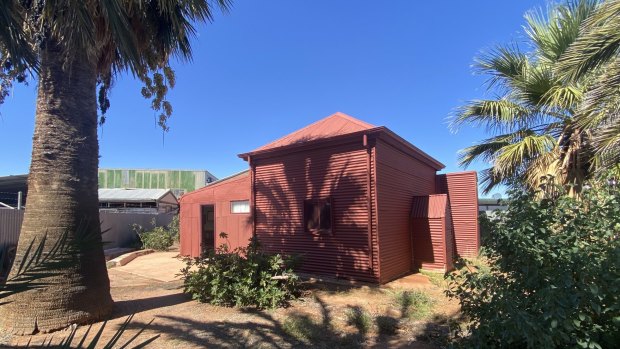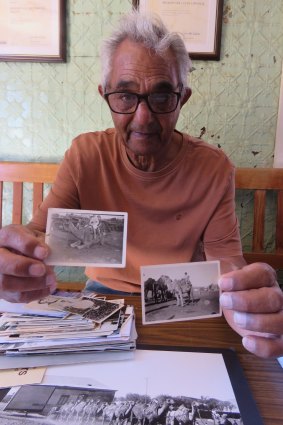This was published 1 year ago
Broken Hill Mosque Museum: The incredible history and cameleers behind outback Australia's last mosque

The Broken Hill Mosque Museum offers a history lesson like no other.Credit: Katrina Lobley
The Broken Hill Mosque Museum, marking the site of a former camel camp, is officially open two hours a week. At other times, you just give co-ordinator Bobby Shamroze a call on the blower and he'll come to open the high chain-wire gate, show you around and tell one hell of a story.
His history is just as interesting as that of the simple timber-and-tin mosque located in North Broken Hill where Afghan and Indian drivers once loaded their camels, which carted anything from chaff and wool bales to pipes and pianolas. Shamroze is much more than a caretaker of the building that's shaded by date palms and painted a deep desert red. He's a living link to the cameleers who in 1891 built what's now outback Australia's last remaining mosque. His father, Shamroze Khan, and maternal grandfather, Ziadulla Fazulla, were both cameleers who carted freight to the region's stations. Fazulla was the mosque's last mullah (religious leader).
Shamroze, 82, doesn't know a whole lot about his dad, a camel dealer and driver who managed to make and lose a fortune before his death in 1952. "My old man was 62 when I came along," Shamroze says. "Couldn't find nothin' out about him and still can't find nothin' out about him."

Bobby Shamroze is a living link to the cameleers who in 1891 built what's now outback Australia's last remaining mosque.Credit: Katrina Lobley
His mother, Miriam, decades younger than her husband, abandoned the family when Shamroze was four years old. "After mum went, it was rough," he says of his childhood. When he was a small child, "I jumped on the train and ran away to Adelaide to look for my mother".
"I just found my way around the place because I'd been down there with my father," he says. "He used to go down to the Adelaide mosque." Those were the days, he says, when "you could go missing for a month and no one would worry about you".
The last time he ran away, he found his mum who was working at a pub. He started going to school in Adelaide but was soon placed in a series of boys' homes. Shamroze returned to Broken Hill to briefly live with his grandfather before becoming a shearer, wool presser and mines worker. At 17, he met his future wife. He and Janet remain happily married 65 years later.
It's a story as colourful as the mosque, which faces towards Mecca. The non-religious Shamroze – "When I was in the boys' home, I went to a different church every week" – never had much to do with the mosque in his younger years, apart from when his grandfather died in 1960. Shamroze and his uncle washed his body there before burial.
With Fazulla's passing, the mosque fell into disrepair. After the Broken Hill Historical Society restored the building, it was rededicated as a place of worship in 1968. Today, the anteroom displays photographs, books and artefacts, and Muslim visitors occasionally come to kneel on prayer mats in the adjoining mint-green prayer room fashioned from sheets of pressed metal.
Under cover in the yard is a weathered wagon, once drawn by as many as 16 camels. These wagons were just as important as the camel trains when it came to hauling heavy supplies around the outback. In the 1920s, motorised transport usurped camel-powered haulage.
Although Shamroze Khan remains quite the enigma, another trace of him can be found in Broken Hill. The cameleer's now-faded gold-embroidered, emerald-green silk velvet jacket, once displayed at the mosque, is now part of the Sulphide Street Railway and Historical Museum's collection. The fancy threads speak of Khan's one-time wealth but no one knows for sure where and when it came to be in his possession.
His son never gave much thought to the family's incredible history but that all changed when Shamroze joined the historical society then started looking after the Mosque Museum about 12 years ago. "I'm here to keep the history and the name – and try to get a bit of a name for the old camel drivers who worked the country," he says.
THE DETAILS
FLY
Qantas flies from Sydney to Broken Hill thrice-weekly. See qantas.com
SEE
The Broken Hill Mosque Museum is at 703 Williams Street; entry by gold coin donation. The museum is open Fridays from 11am-1pm or by appointment. See brokenhillhistoricalsociety.com
MORE
The writer was a guest of Qantas and Destination NSW.
Sign up for the Traveller Deals newsletter
Get exclusive travel deals delivered straight to your inbox. Sign up now.